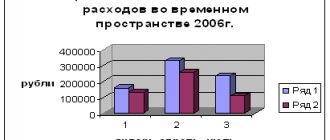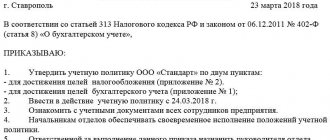Document approval deadlines
There is an opinion that accounting policies must be approved at the end of each calendar year. But that's not true. If nothing has changed in the activities, accounting and taxation of the organization, then there is no need to “re-approve” the document. You should use the existing one. If changes occur, you will have to rework the document. It is permissible to approve adjustments by a separate order, defining only specific innovations. The organization also has the right to cancel the old rules for reflecting business transactions and generating reports and prepare a new order.
The deadlines for approval and amendments to accounting policies are determined at the legislative level:
| Event | Approval period for BU | Deadline for tax accounting |
| Creation of a new organization | Approve the accounting rules no later than 90 calendar days from the date of registration of the organization (clause 9 of PBU 1/2008) | Approve the new accounting policy no later than the end of the first reporting tax period (clause 12 of article 167 of the Tax Code of the Russian Federation) |
| Alteration | According to generally accepted requirements, make changes in the current period, but apply the updated provisions from the new calendar year (clause 10 and clause 12 of PBU 1/2008) | If the company has changed its tax accounting methods or there have been significant changes in its activities, then the changes in accounting policies should be applied from the new tax period (Article 313 of the Tax Code of the Russian Federation). When changing legislative norms, use innovations from the date of entry into force of legislative innovations |
| Making additions | At the moment when clarifications and additions became necessary for further accounting (clause 10 of PBU 1/2008) | Approve the additions in the period in which these clarifications became necessary for tax accounting (Article 313 of the Tax Code of the Russian Federation) |
Please note that addition and modification are completely different things.
To quickly and correctly draw up a document, use the free accounting policy designer for 2021 from ConsultantPlus experts.
Samples of accounting policies for 2021
Accounting policy is an important component used in the simplified taxation system for 2021.
In written form, the accounting policy is documentation that shows all possible options for organizing the company's accounting. 02/01/2016
Today, the requirements and conditions by which the accounting policy of an enterprise is regulated and fully disclosed are described in PBU 1/2008. This provision provides the following information:
- accounting chart of accounts, which is used by accountants when preparing transactions and financial statements;
- forms of primary papers, accounting registers, documentation regarding accounting;
- a set of sequential measures that allow different options to properly assess the assets and liabilities owned and assigned to the organization;
- requirements for document flow and information processing technology regarding accounting;
- orderly and consistent control and audit of all business transactions carried out by the enterprise during the implementation of its economic activities for the reporting period;
- other decisions without which the correct organization of accounting is impossible.
In accounting and tax accounting, it is important to timely and fully reflect all changes and facts of the organization’s economic activity; delays in submitting documentation are not allowed; penalties and interest are provided for any delays.
In the event that an enterprise, in addition to being on the simplified tax system, belongs to the list of those engaged in small business, the organization can claim the opportunity to simplify the options for organizing accounting. If a company is subject to simplification, the accountant must mention this in the necessary documentation, and this accounting policy must henceforth be used annually.
Justified reasons for making changes to accounting policies may include:
- changes in the requirements specified by Russian legislation, standards at the level of the federal industrial structure;
- development, implementation or selection of an updated version of accounting, if its use will make it possible to improve the quality of information provided about the accounting object;
- tangible changes in the activity options of an economic entity.
If it is customary to make changes to the structure of accounting policies, this should be done at the beginning of the year. Changes come into force as soon as written consent is given by the head of the enterprise, i.e. will issue an appropriate order with the necessary text. So, in order to avoid any problems with the tax inspectorate, changes in accounting policies that involve work in 2021 are best carried out according to the documents at the end of the reporting year 2015.
What points are desirable to be reflected in the accounting policies that are relevant to organizations conducting accounting using the simplified tax system in 2016?
1. The use of a reduced number of synthetic accounts in the accepted planning of accounting accounts in comparison with the Chart of Accounts, which were confirmed by order of the Ministry of Finance of Russia back in 2000 and are valid until 2021.
Basic provisions for an accountant submitting reports for the 1st quarter of 2021
- Firstly, it is imperative to familiarize yourself with the new list of BCCs and download them.
- Secondly, it is impossible to avoid mistakes without knowing the exact deadlines for submitting financial statements in 2021.
- FSS benefits.
- It is required to confirm the main type of economic activity of the enterprise in the Social Insurance Fund service.
- And finally, you cannot do without understanding exactly what reporting documents should be provided to the statistical authorities as of the 1st quarter of 2021.
Business transactions | Total score | Accounts that can be combined |
| Inventory accounting | 10 "Materials" | 10 "Materials" 07 “Equipment for installation” 11 “Animals in cultivation and fattening” |
| Accounting for costs associated with the production and sale of products | 20 "Main production" 44 “Sales expenses” | 20 "Main production" 23 “Auxiliary production” 25 “General production expenses” 26 “General business expenses” 28 "Defects in production" 29 “Service industries and farms” |
| Accounting for finished products and goods | 41 "Products" | 41 "Products" 43 “Finished products” |
| Accounting for receivables and payables | 76 “Settlements with various debtors and creditors” | 62 “Settlements with buyers and customers” 71 “Settlements with accountable persons” 73 “Settlements with personnel for other operations” 75 “Settlements with founders” 76 “Settlements with various debtors and creditors” 79 “Intra-economic settlements” |
| Cash accounting in banks | 51 “Current accounts” | 51 “Current accounts” 52 “Currency accounts” 55 “Special bank accounts” 57 “Translations on the way” |
| Accounting for a company's capital | 80 “Authorized capital” | 80 “Authorized capital” 82 “Reserve capital” 83 "Extra capital" |
| Accounting for financial results | 99 "Profits and losses" | 90 "Sales" 91 “Other income and expenses” 99 "Profits and losses" |
2. Do not use PBU 2/2008 under the name “Accounting for construction contract agreements”, put into effect by order of the Ministry of Finance in 2008.
3. Do not show estimated, contingent liabilities and assets in accounting, do not create reserve amounts for future expenses, for example, for possible payment of vacation days to employees, payment of remuneration amounts based on the organization’s performance for the last calendar year, this may also include a guarantee maintenance or repairs performed under warranty.
4. If there is no basic information, without understanding of which it is not possible to assess the financial condition or results of operations of the enterprise, accounting documentation should be generated in such a way that the reduced volume includes:
- Form No. 1 – balance sheet, without which accounting essentially does not exist;
- a report that reflects all types of business activities, works and services during the current reporting period.
5. Reflect in the balance sheet and income statement values solely by category of items without listing detailed information on the accounts.
6. Leave information regarding related parties inaccessible in reporting documentation.
7. Do not provide information regarding the type of economic activity of the subject being terminated.
8. Describe in the accounting documentation the consequences that will follow changes in the accounting policies of the enterprise, which may have or have already had a certain impact on the financial condition of the business, have allowed new financial results to be obtained, or will still allow in the future.
9. Make corrections to errors made if they are of great importance for the accounting of the previous year, identified later. In this case, a retrospective recalculation is not required.
10. Enter a list of primary accounting documentation that is used to reflect the economic activities of the organization. Today there is no need to fill out absolutely all available ones; the law does not provide for this, so the entrepreneur is given the right to choose, having certainly received advice from tax officials before doing so. Only cash documents remain mandatory.
The list of primary documentation is drawn up and certified by the head of the company himself; a list of positions and specific individuals who can sign primary documents in the absence of the founder is also indicated here. All rights of these subjects are specified in part 1 of Article 7 and Article 9 of Law %402-FZ.
An example of registration of accounting policies according to the simplified tax system as of 2021
Astra LLC
Order No. 23
on approval of accounting policies for accounting purposes
St. Petersburg 12/29/2015
1. Approve the accounting policy for accounting purposes as of 2016 in accordance with the appendix.
2. Control over the implementation and execution of the order is assigned to the chief accountant A.V. Petrov.
Director V.K. Smirnov
Appendix to the order dated December 29, 2015 No. 23
Accounting policies for accounting tasks
The accounting policy for solving accounting problems is formed on the basis of the Law “On Accounting”, which was published in 2011, and is supported by a number of equally important Regulations, a Chart of Accounts and Instructions for its correct use.
According to the stated legislative acts, the accounting policy includes the following principles and components:
1. Accounting is organized by a special department, a division that exists in every enterprise. This important structure is headed by the chief accountant.
2. Double entry is used in accounting. What does it mean? Any change in the expenditure part is reflected on 2 lines at once, which allows you to achieve a holistic balance of components.
3. Accounting is always subject to and corresponds to the Chart of Accounts, which are indicated in Appendix 1.
4. If changes in accounting policies are coming, they should be shown point by point and sequentially.
5. Separate employees or divisions are not needed to maintain a separate balance sheet.
6. Primary reporting forms are always constant and developed in a single format.
7. People holding certain positions can claim the right to sign documents if their superiors are absent. Their list is included in Appendix 2.
8. The accounting register is the Business Accounting Book, indicated in the Appendix, which also describes the current principles of accounting policy in the organization.
9. It is customary to take 1 calendar month as the reporting period.
10. How significant the level is is indicated in the amount of 5% of the total size of the object for which accounting is kept, or the corresponding accounting item.
11. If there is a need to get rid of an error made in the last reporting period, identified by the accountant independently, it is necessary to make an appropriate entry in the current statements, where the necessary entries and accounts are indicated.
12. As for the inventory, which affects the property and liabilities of the organization, it is initiated at least once a year and is a preparatory stage for drawing up a balance sheet for the year.
13. There is no need to revaluate fixed assets.
14. An object accepted by an accountant on the balance sheet is always considered a fixed asset, but only if it is used in the statutory work of the enterprise or for the needs of management and control.
In this case, pay attention to the conditions:
- the object must be suitable for use over a long period of time, for a period of 1 year or more;
- the company is not considering selling the property in the future;
- the price of the object in the form in which it arrived at the organization is more than 40,000 rubles.
15. How long fixed assets can be used is indicated in the 2002 Classification of Fixed Assets.
16. Depreciation calculations are carried out without taking into account reduction factors.
17. Depreciation is calculated using the straight-line method.
18. If the property has been registered with the enterprise for more than 1 year, and its original price was 40,000 rubles, write-off occurs gradually.
19. Costs related to property repairs are included in the organization's costs, but they never include costs for regular, planned repairs required by technological requirements.
20. Inventory in the warehouse is distributed to account 10.
21. Finished products should be charged to account 41.
22. The number of each individual material stock is taken as the unit of inventory calculation.
23. Purchased inventories are carried taking into account the actual cost, account 16 does not apply.
24. If inventories are removed from accounting, they should be reflected in accounting based on the average cost.
25. The cost price for inventories is the price at which the property was purchased from the supplier; it is advisable to confirm the cost with a document.
26. The cost also includes transportation and procurement costs.
27. There is no need to reflect the revaluation of intangible assets.
28. If an intangible asset has depreciated, there is no need to show this on the accounts or balance sheet.
29. Depreciation in the context of intangible assets is shown in the same way as depreciation of tangible assets.
30. Expenses related to the production and sale of goods and services are allocated to account 20.
31. Accounts receivable and payable should be included in account 76.
32. Debt obligations are a type of other costs.
33. The volume of money supply located in bank accounts is assessed in account 51.
34. Capital accounting is possible using account 80.
35. Revenue is determined in accordance with the procedure for receiving money from customers or clients, if the basic conditions described in categories a, b, c and d of paragraph 12 of PBU 9/99 are met.
36. Accounting for the results of a company’s economic activities includes reflection on account 99.
37. If there is a formalized and signed agreement regarding a construction contract, the profit and cost part are provided without the use of PBU 2/2008.
38. Investments assume the unit of accounting policy is a series.
39. Expenses received as a result of the acquisition of financial investments, in value less than the level of materiality fixed in paragraph 10 of the current accounting policy at the enterprise, are classified as other expenses.
40. The current market price of financial investments, on the basis of which the market valuation is determined, is subject to adjustments and changes every 3 months.
41. If it is impossible to understand the market price from financial investments, then the investments must be displayed in accounting, focusing on the reporting number for the primary cost.
42. The cost of financial investments takes into account each unit separately.
43. The extent to which financial investments have lost weight must be monitored annually; this is done with the aim of timely formation of a reserve.
44. Contributions to the reserve for doubtful debts are made every quarter.
45. There is no need to create a reserve for future vacation pay for employees.
46. PBU 18/02 is not valid.
47. PBU 11/2008 is not used.
48. PBU 16/02 does not apply.
49. Those persons who have the right, on the instructions of their superiors, to receive accountable money are included in Appendix 3. Advance accounts are generated and then shown no later than 30 calendar days. When the employee returns home, within 3 days he is obliged to submit a report on expenses to his superiors.
50. The schedule for the movement and display of documents is determined by the order of the head of the organization. The chief accountant is responsible for maintaining the schedule.
51. The preparation of interim reporting and documentation for the year involves the use of balance sheet report forms according to Form 2.
52. Mandatory documentation, at the request of the owner, can be supplemented with additional papers, for example, a report on changes in capital and on the movement of money supply. Such documents help to create a more complete picture of the organization’s current financial position.
Chart of accounts for an accountant
Syntheticchesical check | Account name |
| 01 | Fixed assets |
| 02 | Depreciation of fixed assets |
| 03 | Profitable investments in material assets |
| 04 | Intangible assets |
| 05 | Amortization of intangible assets |
| 08 | Investments in non-current assets |
| 08-1 | Acquisition of land plots |
| 08-3 | Construction of fixed assets |
| 08-4 | Acquisition of fixed assets |
| 08-5 | Acquisition of intangible assets |
| 10 | Materials |
| 19 | VAT on purchased assets |
| 20 | Primary production |
| 21 | Semi-finished products of our own production |
| 41 | Goods |
| 45 | Goods shipped |
| 50 | Cash register |
| 50-1 | Cash desk of the organization |
| 50-2 | Operating cash |
| 50-3 | Money documents |
| 51 | Current accounts |
| 58 | Financial investments |
| 60 | Settlements with suppliers and contractors |
| 63 | Provisions for doubtful debts |
| 66 | Calculations for short-term loans and borrowings |
| 66-1-1 | Principal amount of debt on short-term loans and borrowings (in rubles) |
| 66-1-2 | Principal amount of debt on short-term loans and borrowings (in foreign currency) |
| 66-2-1 | Interest on short-term loans and borrowings (in rubles) |
| 66-2-2 | Interest on short-term loans and borrowings (in foreign currency) |
| 67 | Calculations for long-term loans and borrowings |
| 67-1-1 | Principal amount of debt on long-term loans and borrowings (in rubles) |
| 67-1-2 | Principal amount of debt on long-term loans and borrowings (in foreign currency) |
| 67-2-1 | Interest on long-term loans and borrowings (in rubles) |
| 67-2-2 | Interest on long-term loans and borrowings (in foreign currency) |
| 68 | Calculations for taxes and fees |
| 68-1 | Personal income tax |
| 68-2 | Value added tax |
| 68-3 | Excise taxes |
| 68-4 | Income tax |
| 68-5 | Transport tax |
| 68-6 | Property tax |
| 68-7 | Land tax |
| 69 | Calculations for social insurance and security |
| 69-1 | Settlements with the Federal Social Insurance Fund of Russia for social insurance |
| 69-1-1 | Social insurance contributions in case of temporary disability and maternity |
| 69-1-2 | Contributions for compulsory social insurance against accidents at work and occupational diseases |
| 69-2 | Calculations for compulsory pension insurance (insurance contributions for the insurance part of the pension) |
| 69-3 | Calculations for compulsory health insurance |
| 70 | Payments to personnel regarding wages |
| 76 | Settlements with various debtors and creditors |
| 80 | Authorized capital |
| 81 | Own shares (shares) |
| 84 | Retained earnings (uncovered loss) |
| 86 | Special-purpose financing |
| 94 | Shortages and losses from damage to valuables |
| 98 | revenue of the future periods |
| 99 | Profit and loss |
| 001 | Leased fixed assets |
| 002 | Inventory assets accepted for safekeeping |
| 003 | Materials accepted for recycling |
| 004 | Goods accepted for commission |
| 005 | Equipment accepted for installation |
| 006 | Strict reporting forms |
| 007 | Debt of non-paying debtors written off at a loss |
| 008 | Security for obligations and payments received |
| 009 | Security for obligations and payments issued |
| 011 | Leased fixed assets |
| 012 | Computer programs |
List of persons who can receive accountable funds
№p/p | Position, full name | With an orderfamiliarized |
| 1 | Director A.V. Lviv | |
| 2 | Chief accountant A.S. Glebova | |
| 3 | Deputy Director A.N. Tikhomirov | |
| 4 | Senior accountant V.N. Zaitseva | |
| … |
Accounting policy according to the simplified tax system
Tax records are maintained by all entrepreneurs and organizations that fall under the simplified taxation system. First of all, this is beneficial for small businesses themselves, because tax accounting allows, in a number of cases, to defend the accepted accounting procedure.
The tax accounting policy, as well as the accounting policy, is approved exclusively by the manager. How to fill out an order is presented below.
LLC accounting policy for 2021 under the simplified tax system for income, sample
Limited Liability Company "Alfa"
ORDER No. 125
on approval of accounting policies for tax purposes
Moscow 12/31/2015
In order to organize tax accounting at the enterprise
I ORDER:
1. Approve the developed accounting policy for tax purposes in accordance with
Appendix 1 to this order.
2. Apply accounting policies for tax purposes in work starting January 1, 2016
of the year.
3. Entrust control over the execution of this order to the chief accountant
A.S. Glebov.
General Director A.V. Lviv
The order was reviewed by: A.S. Glebova
31.12.2015
Ideally, the tax accounting policy should be drawn up within the same time frame as the accounting is drawn up; it is preferable not to delay the procedure and invest in the 90-day period for the official registration of the organization. Tax accounting policies do not require annual revision and approval, although if changes are planned, they must be certified by an appropriate document. The document officially signed and certified by the authorities comes into force on January 1.
If you have formed new types of business activities, write them down in additions to the main document on the tax policy of the enterprise. In accordance with current legislation, such additions do not qualify as changes, so there is no need to wait for a specific date; make them as you wish. But you still have to draw up an order.
The fundamental documents on which the tax accounting policy is based are the tax legislation of Russia.
What should be in a document to determine the specifics of tax policy?
1. Issues that are not covered by legislation. For example, a sequence of actions that will help to correctly distribute costs that are not related to work on the simplified tax system or UTII. There is no need to invent anything on your own; rely on the recommendations of employees of regulatory and audit institutions, and judicial practice.
2. Consistent order of formation and accounting of objects and business operations, choose the optimal method.
3. It is necessary to take into account those options that describe actual liabilities and assets. There is no need to rewrite all the methods proposed by law; the choice of method is up to the accountant and the head of the enterprise.
Appendix 1 should be attached to the order, which describes the accounting policy that solves the main tax problems of this company.
Accounting policies for solving taxation problems
1. Tax accounting is carried out by the chief accountant and the department subordinate to him.
2. The amount of the single tax is calculated based on the object as profit.
3. The book in which the expenditure and profit parts are recorded determines the tax base relating to the single tax. But the property is not shown in this book
4. The book is maintained using the computer program “1C: USN”.
5. Each individual business transaction is carried out in the accounting book and is simultaneously entered into the primary documentation.
6. Tax accounting policy does not require the reflection of profits and costs from the revaluation of property if they are presented as currency values.
7. The amount of the advance payment must be reduced by the amount of contributions regularly transferred to the accounts of state insurance funds.
Features of the accounting policy under the simplified tax system “profit minus costs” for 2021
IP Petrov K.L.
Order No. 7
on approval of accounting policies for tax purposes
Kamenets-Podolsky 12/20/2015
I ORDER
1. Approve this tax accounting policy for tax purposes as of 2021, based on the application.
2. I reserve control over the execution of the order.
IP Petrov K.L.
Appendix 1 should be attached below, in which it is necessary to describe the important components of tax policy:
- explain the accounting policy itself.
- establish the procedure for accounting for property subject to depreciation and depreciation;
- keep records of inventory items owned by the organization;
- expense accounting;
- determine the features of accounting for the unprofitable part.
Accounting policies for solving taxation problems
1. Tax accounting is carried out personally by an accountant.
2. The object of taxation is used as the difference between profits and costs.
3. The accounting book is compiled using automated 1C.
4. The accounting book is comparable to the primary reporting data, which reflects all business transactions.
Accounting policy for depreciable assets
5. The primary value of a fixed asset in material equivalent is indicated in the amount of expenses actually incurred for its purchase, production, arrangement in the sequence specified in the legislation.
6. If the fixed asset is paid for, the primary price, together with the costs of its equipment, is included in the book of income and expenses in equal parts, starting from the quarter when the fixed asset was put into operation until the end of the calendar year.
7. The part of the price of a fixed asset purchased during the operation of the simplified tax system, which is recognized in a given period, is calculated by dividing the primary cost by the number of quarters that remain until the end of the year, including 3 months, when the rules and requirements for writing off the price of the object are met in the amount of costs.
Accounting for inventory items
8. Material costs consist of the cost of purchasing materials, costs of bonuses issued to employees, customs duties, transportation costs, as well as losses incurred from the need to use computer and information services. VAT withheld on the purchase of inventories should be entered in a separate column when they are recognized as materials included in expenses.
9. Material costs are taken into account as payment is made and are subject to adjustment for the price of materials not yet applicable in commercial activities.
10. Expenses associated with fuel and lubricants are taken into account according to the norm in material costs.
11. Standards for recognizing costs for fuel and lubricants are distributed and indicated in the order of travel; the basis for drawing up documentation is waybills. The amounts entered into the book cannot exceed the established limits.
12. The price of products purchased for subsequent sale is indicated based on the purchase price in accordance with the concluded agreement.
13. The price of goods put up for resale is included in expenses as the products are sold; the chosen valuation method is the average cost.
14. VAT is also described as goods are sold.
15. Costs related to the purchase of products are recorded as expenses as the debt is actually repaid.
16. An entry in the accounting book is made based on a payment order or invoice for the release of products to the client.
Cost accounting
17. Costs associated with storage and transportation of products to the buyer are classified as sales costs. This also includes losses incurred as a result of paying rent, arrangement of premises, and advertising expenses.
18. Expenses involved in the calculation of the single tax are reflected every quarter (except for the cost of fuel and lubricants) on an increasing basis. Adjusting entries are posted in the ledger.
Accounting for losses
19. An individual entrepreneur reduces the tax base for a given reporting period by the full amount of expenses for the previous 10 tax periods. The unprofitable component does not turn into the amount of income when the amount of the single tax does not exceed the limits of the minimum tax paid.
20. The individual entrepreneur claims in expenses the difference between the amount of tax paid at the minimum and the tax amount calculated according to the usual procedure. It also overstates the loss amount that remains for the future.
The initials of the individual entrepreneur are placed at the end of the application. At this point, the approval of the accounting policy for accounting and taxes can be considered complete.
Post:
Comments
Nina
March 15, 2021 at 9:50 am
Approximate position on accounting policies in PMS (production reclamation systems) for 2021
In accounting
The document, entitled “accounting policies for accounting purposes,” discusses general accounting practices and industry specifics.
Regardless of the type of activity, organizations claim:
- working chart of accounts and forms of primary documents;
- a method of controlling the procurement, acquisition and write-off of inventories;
- method of calculating depreciation;
- error correction procedure.
Trade organizations indicate the method of reflecting transportation and procurement costs - in the cost of the goods or as they are sold.
Retail trade organizations indicate the method of accounting for goods - at purchase prices without markup.
Organizations with a long production cycle indicate the method of recognizing income as work, services, and products are ready.
How to check accounting policies
In order to check your existing accounting policy, you need to select the type of accounting policy, and then fill out a form in accordance with the terms of your accounting policy. The designer will issue warnings about the risks, limitations and consequences of choosing accounting methods.
What makes the work easier is that the new Designer allows you to create an accounting policy adapted for a specific organization. The document will reflect the accounting methods used in relation to all objects that exist in the organization.
In tax accounting
Depending on the applied tax regime, the accounting policy considers the following issues:
- income recognition method for calculating income tax: cash or accrual;
- method for determining the cost of write-off of materials and goods: by unit cost, weighted average or FIFO method - by the cost of the first purchases;
- method of calculating depreciation of fixed assets and intangible assets: linear or non-linear;
- the possibility of accruing reserves to regulate income tax: for doubtful debts for vacation pay, for warranty repairs and repairs of fixed assets;
- tax register form for calculating the taxable base: book of income and expenses, book of sales and book of purchases, independently developed registers.
Read more about the formation of accounting policies for tax purposes
For small businesses
Small businesses (SMBs) have the right to use simplified accounting registers and submit simplified financial statements.
If an organization wants to exercise this right, it must be written down in a document.
SMP has the right to refuse to apply 6 accounting standards, such as “Accounting for construction contracts” (PBU 2/2008), “Estimated liabilities, contingent liabilities and contingent assets” (PBU 8/2010) and others.
All accounting standards that are not applied by the entity should be listed in a special section “Application of accounting provisions.”







